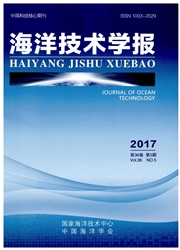

 中文摘要:
中文摘要:
根据2013年01月(冬季)和2013年06月(夏季)的调查数据对湛江港海域海水和表层沉积物中的重金属(铜、锌、铅、镉、砷和汞)进行了研究,调查结果显示调查海域海水和表层沉积物中重金属含量呈现岸边海域高于深海海域,东海岛北面海域高于东面海域;对比冬季和夏季的调查结果,调查海域海水中重金属平均含量夏季高于冬季。用单项污染指数对海水中的重金属进行了评价,结果表明,冬、夏两季海水中的Pb污染较明显,Cu和Zn轻度污染,其余元素(Cd,As和Hg)均未超过相应的国家海水水质标准限值,夏季重金属污染指数高于冬季,可能与陆源重金属污染物入海的影响有关;表层沉积物中重金属均低于相应的标准限值,沉积物环境质量状况良好。采用瑞典科学家H?kanson的潜在生态危害指数法进行评价,沉积物中重金属的潜在生态危害较轻,生态危害程度Hg>As>Cd>Pb>Cu>Zn。
 英文摘要:
英文摘要:
According to the survey data in January 2013 (Winter) and June 2013 (Summer), this paper studies the heavy metals (copper, zinc, lead, cadmium, arsenic and mercury) in seawater and surface sediments from the Zhanjiang Harbor. The survey results show that the contents of heavy metals in offshore sea are higher than in deep sea, and that those in the northern sea area of the Donghai Island are higher than in the eastern sea area. Comparison of the survey results indicates that the average contents of heavy metals are higher in summer than in winter. The single factor index method is applied to analyze heavy metal pollution in seawater. The results show that in the two seasons, the seawater is seriously polluted by Pb and slightly polluted by Cu and Zn. The contents of other elements (Cd, As and Hg) are not over the National Se a Water Quality Standard for the corresponding values in seawater. The respective factor indices of heavy metals in seawater in summer are higher than those in winter, which might be due to many pollutants from land sources in summer. All heavy metal contents in marine surface sediments are all lower than standard values, showing that the environmental quality of sediments is in good condition. The Potential Ecological Risk Index method proposed by Swedish scientist H?kanson is applied to evaluate the harm of heavy metals. The results indicate that the potential ecological risk of heavy metals in the sediments is relatively slight, and the sequence of their potential ecological risk is Hg>As>Cd>Pb>Cu>Zn.
 同期刊论文项目
同期刊论文项目
 同项目期刊论文
同项目期刊论文
 期刊信息
期刊信息
